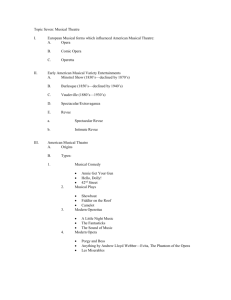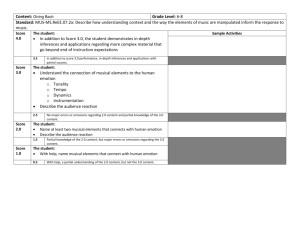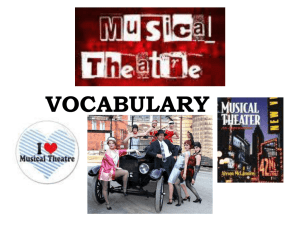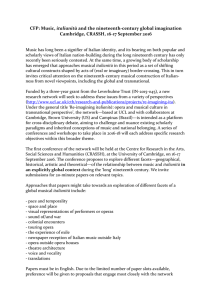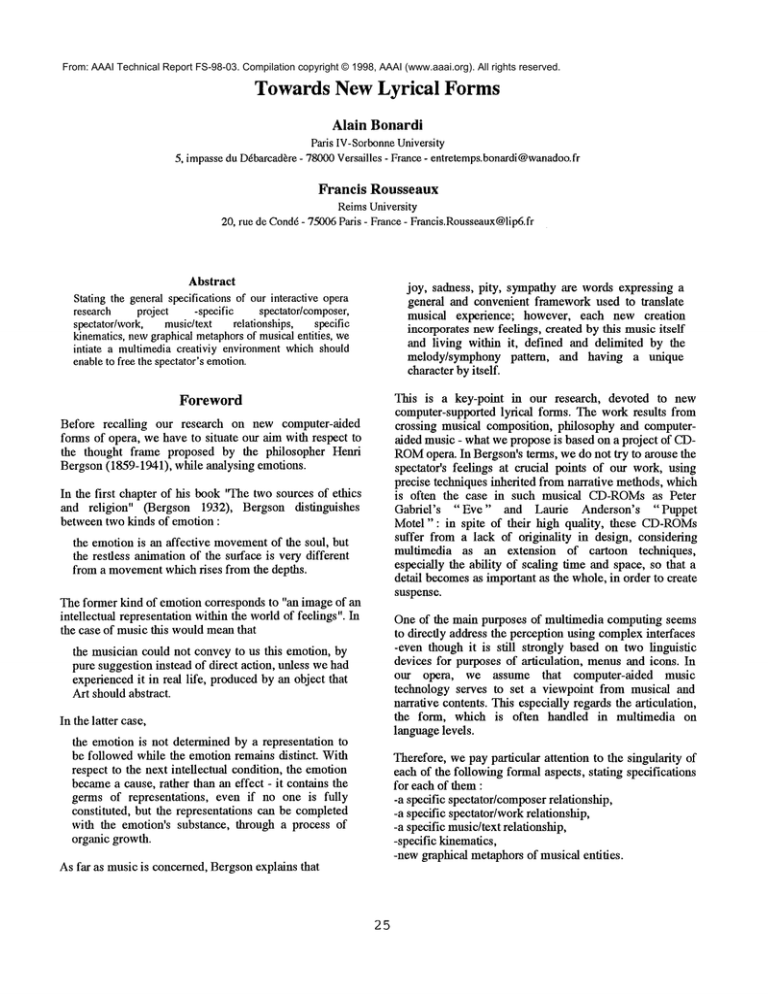
From: AAAI Technical Report FS-98-03. Compilation copyright © 1998, AAAI (www.aaai.org). All rights reserved.
Towards New Lyrical
Forms
Alain Bonardi
Paris IV-Sorbonne
University
5, impassedu Ddbarcad~re
- 78000Versailles - France- entretemps.bonardi@wanadoo.fr
Francis Rousseaux
ReimsUniversity
20, rue de Cond6- 7.5006Paris - France- Francis.Rousseaux@lipt.fr
Abstract
Stating the general specifications of our interactive opera
research
project
-specific
spectator/composer,
spectator/work, music/text relationships, specific
kinematics,newgraphical metaphorsof musicalentities, we
intiate a multimediacreativiy environmentwhichshould
enableto free the spectator’semotion.
joy, sadness, pity, sympathyare words expressing a
general and convenient framework used to translate
musical experience; however, each new creation
incorporates newfeelings, created by this musicitself
and living within it, defmed and delimited by the
melody/symphony pattern, and having a unique
character byitself.
This is a key-point in our research, devoted to new
computer-supported lyrical forms. The work results from
crossing musical composition, philosophy and computeraided music - what we propose is based on a project of CDROM
opera. In Bergson’s terms, we do not try to arouse the
spectator’s feelings at crucial points of our work, using
precise techniques inherited from narrative methods, which
is often the case in such musical CD-ROMsas Peter
Gabriel’s
"Eve" and Laurie Anderson’s "Puppet
Motel ": in spite of their high quality, these CD-ROMs
suffer from a lack of originality in design, considering
multimedia as an extension of cartoon techniques,
especially the ability of scaling thne and space, so that a
detail becomesas important as the whole, in order to create
suspense.
Foreword
Before recalling our research on new computer-aided
forms of opera, we have to situate our aim with respect to
the thought frame proposed by the philosopher Henri
Bergson (1859-1941), while analysing emotions.
In the first chapter of his book’q’he two sources of ethics
and religion" (Bergson 1932), Bergson distinguishes
between two kinds of emotion:
the emotionis an affective movement
of the soul, but
the restless animationof the surface is very different
from a movementwhich rises from the depths.
The former kind of emotion corresponds to "an image of an
intellecttml representation within the worldof feelings". In
the case of music this wouldmeanthat
One of the main purposes of multimedia computing seems
to directly address the perception using complexinterfaces
-even though it is still strongly based on two linguistic
devices for purposes of articulation, menusand icons. In
our opera, we assume that computer-aided
music
technology serves to set a viewpoint from musical and
narrative contents. This especially regards the articulation,
the form, which is often handled in multimedia on
languagelevels.
the musician could not conveyto us this emotion, by
pure suggestion instead of direct action, unless we had
experiencedit in real life, producedby an object that
Art should abstract.
In the latter case,
the emotionis not determined by a representation to
be followed while the emotion remains distinct. With
respect to the next intellectual condition, the emotion
becamea cause, rather than an effect - it contains the
germs of representations, even if no one is fully
constituted, but the representations can be completed
with the emotion’s substance, through a process of
organic growth.
Therefore, we pay particular attention to the singularity of
each of the following formal aspects, stating specifications
for each of them:
-a specific spectator/composerrelationship,
-a specific spectator/workrelationship,
-a specific music/text relationship,
-specific kinematics,
-newgraphical metaphorsof musical entities.
As far as musicis concerned, Bergsonexplains that
25
A Specific
Spectator/Composer
"volume" (not only a sound volume, but also the
combinationof rich componentsrelative to theatre, music,
poetry, scenery, dance, lighting, etc.) - wetake into account
the loneliness of the modernspectator.
Relationship
The commonpoint between the different approaches to
multimedia computingis that they rely on the exploration
of more and more sophisticated interfaces to capture the
user’s intention. The question is therefore to characterize
what we imagineto be the user’s intention in our opera :
A Specific
-this intention does not strictly belong to a play activity;
contrary to Peter Gabriel’s "Eve" and Laurie Anderson’s
"Puppet Motel" CD-ROMs,
where the user’s intention is
the exploration of a realistic space, in a quest of musical
objects,
In this context, somecausality links, induced by classical
narration procedures, have to be blurred and replaced, as
Umberto Eco (Eco 1962) said
-the user’s intention is confrontedto an object whichis not
a simulation of part of the real world. It is not a
reproduction of an art work, as proposed by the CD-ROM
edited by museums.The object is the workitself, that only
exists in the privileged relationship created between the
user and the computer,
-the user’s intention is not to be the spectator of a narration,
-the user’s intention is a creative one, and the composer’s
creativity serves to set a creativity environment,based on
simple gestures such as the tempocontrol (as a conductor),
the possibility of discovering one’s own journey in the
work, the idea of linking different levels of affects, as we
explain further.
Spectator/Work
Relationship
Besides, in this lyrical work, musicis preferred to text, in
particular to narrative contents. So, if the "Blue-Beard"
digital opera project (CD-ROM
and Internet) of Jean-Pierre
Balpe, Alexandre Raskatov, and Michel Jaffrennou, is
based on a text/narration
generation engine allowing
variations around a well-known pattern, our approach is
completelydifferent. Wedo not, obviously, reject the text,
but we refuse its essential part in WesternOpera, based on
the chain: libretto->music->production.
-this intention does not strictly deal with formal and
combinatory aspects; contrary to Kaija Saariaho’s
"Prisma" CD-ROM
project, where the user can build
several possible works, using parts of the original piece,
A Specific
Music/Text
by a small universe which can be examined from
various viewpoints, thus totally independent of
Aristote’s poetical laws, and so, of the irreversible
time flow through an homogeneousspace.
We propose here to explore music by opening an
imaginaryworld, in the spirit of the opera extracts from the
videotape "OpEraImaginaire", i.e. the potential of visual
support/synthetic imagesis used to constitute a true dreamlike journey, instead of an almost redundantillustration of
the songtexts.
Specific
Kinematics
From the viewpoint of cinematic progress, we desire that
the work owns a default flow - the opera can continue
without any user’s action, following a given pattern, very
similar to that of a videotape. Gradually, the user
understands that his/her desired intervention can interfere
with the work.
Relationship
Let’s assumethat this lyrical workis producedfor a unique
listener-user
(multi-listener
network connection is
excluded), who is facing towards his/her computer. This
illustrates the intimate relationship desired by Morton
Subotnick in his CD-ROM,"All Hummingbirds Have
Alibis", subtitled "ChamberMusic for CD-ROM".
This idea has two modalities:
- choice of open forms, and
- integration of computerised menus into the dramatic
process.
The opera is no longer a ritual, a pilgrimage, as Franz Liszt
presented Richard Wagner’s’q’annh~iuser" (Liszt 1995)
As far as open lyrical forms are concerned, we shall
underline the difference between the scene approach, like
that of the composerHenri Pousseur in the opera ’q(our
Faust" (1960-1968) and the one we propose today.
already stated, the interactivity is no longer a participation
of the public in the spectacle’s progress, but an individual,
or even exclusive relationship betweenthe listener and the
computerised work.
this religious principle, this Radiant Light, is
represented in the overture by a theme which becomes
in the opera a pilgrim’s song. Whenlistening to this
song, during the momentswhere Spirit freely indulges
in Illusion [...], this song reverberates like the whole
Mankind’splaintive, hopeful and longing voice during
the pilgrimage to Holy Rome.
Here, we are far from the case of classical opera, where
public was viewed as a single entity with a sufficient
26
So, our initial research addressed the metaphors based on
"corridors",
where the user moves with a speed
proportional to the music’s tempo. It is possible to change
this speed within a tempo area, centred either on a value
given by the composer, or on a meanvalue extracted from
several recordings of the piece of music concerned. We
consider that the possible understanding of music through
gestures attached to the tempois very important- e.g. one
of the first steps in studies on orchestra/choir direction is
understanding the beat time, which establishes
a
relationship between the gesture and the musical result
obtained. Here, on a more modest basis, we could imagine,
as a second step, an interface driven by a simple device
(mouse or joystick) allowing us to vary the tempo while
movingthrough the corridors.
For a listener/user of an interactive opera, the relationship
with the work is always personal and variable - it is an
object that has to be discovered each time. Furthermore,
this relationship can have temporal characteristics,
allowing a degree of work’s appropriation by the listener.
That’s different from fifties and sixties open works(Pierre
Boulez’ third sonata for piano or Andr6 Boucourechliev’s
"Archipel IV", which did not allow the public to appreciate
a potential of renewal whenthey were played once or twiee
during a concert.
As far as computerised menus are concerned, we choose
cinematic realisations different from those currently used
in CD-ROMs,
based on compulsory choices with a spatial
organisation; in most cases, the menuchoosing the next
sequence takes the form of a waiting sequence (clumsily
emphasisedby a numericalloop), whichlasts until the user
finds out in the scenery the element allowing the access to
the following episodes. This design introduces a dramatic
discontinuity, which heavily influences the process, by
favouring the game, and in particular the enigma, whose
solution conditions the access to somesequences.
The gronnd of the corridors includes steps whose height
varies depending on the bass line of the piece of music.
The ceiling includes horizontal plates whoseheight varies
depending on the highest note. The last geometric
parameter is the corridor’s breadth, depending on the
vertical density of the discursive expression, i.e. the
number of notes sounded at the same time - when this
numberrises, we feel that the spectrumis saturated, like a
narrowcorridor.
On the contrary, we think of animating the choices and
integrating
them as independent components of the
dramaturgy. The deliberate absence of choice should be
explicitly chosen. Furthermore, possible choices should be
instantaneously available in both musical and narrative
forms.
Let’s consider a simple example: the first four bars of the
Variations Diabelli theme, Beethoven’s opus 120 (Henle’s
prin0:
TowardsGraphical Metaphors
of MusicalEntities
Since we want to animate musical contents where the user
can express his/her preference, we need graphical
representations of musical fragments in the frameworkof
our interactive opera.
P
figure 1 : beginningof Beethoven’s
Diabelli Variations
To build the corridor’s model, the f’trst step is to reduce
harmonically the piece of music. Here, the result is
manually obtained by suppressing passage notes,
embroideries and appoggiaturas, and by linking the
identical chords which are repeated:
In a paper entitled "Exploring Musical Space by Meansof
Virtual Architecture ", GerhardEckel, in the frameworkof
the "CyberStage" project, addresses some virtual
architectures wheremusicis kept like a jewel in its casket_
Music is placed in this imaginary space in a protective
house whoserooms represent each one a musical situation.
On the basis of well knownsymbols, this author def’mes
spatial relationships inherent in music(e.g. proximity vs.
distance, etc.), as well as possible solutions for the form’s
openness.
Our approach is more specifically devoted to musical
contents. Wehave to distinguish here betweentwo levels:
that of the analytic internal representation - i.e. a dynamic
trajectory through the musical space while musicis listened
to, and that of a synthetic external representation - i.e. the
reduction of a musical fragment to an object having to
represent it. Upto now, we limited our study to the first
level of representation, where the listener really plunges
into the musical space.
figure2 : reductionof the 4 bars
By taking into account density variations, we obtain the
corridor shownbelow (for readability’s sake, only the very
beginningof the left-side temporal wall is drawn):
27
References
,.-
~.f
,,,
~
"-...;_~.," ,,t ,.,,’ ..L;~’...,_.~,..-~.~
Articles
and Books
Bachimont, B., 1996. L’intelligence artificielle
comme
6criture dynamique: de la raison graphique ta la raison
computationnelle. Cerisy la Salle Conference "Au nomdu
sells". Forthcoming.
figure3 : buildingof a corridor
The piece of music begins at the left-hand top-side of the
diagram. Groundsteps follow the pattern: C3-G2-C3-G2C3-E2-G2-C2,while the ceiling’s pattern is: CS-G4-DS.
Densitysuccessivelytakes the values of: 1, 2, 4, and t’mally
1. The next figure showsthe wholecorridor :
Bergson, H., 1932. Les deux sources de la morale et de la
religion. Paris : Presses Universitaires de France.
Bonardi, A., 1997. Vers un opfra interactif. DEAthesis,
’~vlusic and Musicology in the 20-th century" doctoral
cycle EHESS/ParisIV Sorbonne.
Boucourechliev,
Paris : Fayard.
A.,
1993.
Le langage
musical.
Chemillier, M., and Pachet, F., 1998. Analyse de
structures. In Recherches et applications en informatique
musicale. Paris : Hermes
Eckel, G., 1997. Exploring Musical Space by Means of
Virtual
Architecture.
Paper
available
at
http://viswiz.gmd.del~eckellpublicationslecke197b/ecke197
b.htm
figure 4 : the wholecorridor
The user can be viewed as a character whomovesthrough
the corridor depending on the music’s tempo. To complete
the representation of musical parameters, we project the
use of colour for the rectangular areas. So, in the previous
example, harmonic reduction
causes the total
disappearanceof the "ostinato" effect of C-E-Gtriads at the
right hand. To represent the streaked aspect of this time
slice, we could use bright areas intertwined with dark ones,
to be comparedwith the scenery seen from a train r~mning
through an open work fence tunnel. Finally, in the
frameworkof an opera, these rectangular areas could play a
dramatic part, since they can support the text keywords,as
well as imagesor icons.
Eco, U., 1962. L’opera aperta. Milan : Bompiani.
Liszt, F., 1995. Artiste et sociftf. Texts gathered by Rfmy
Stricker. Paris : Flammarion
Videotapes
La Cinquifme Video (5th French Channel), 1995. Opfra
Imaginaire. 12 opera extracts illustrated by 12 synthetic
image studios.
CD-ROM
Anderson, L., 1995. Puppet Motel. Gallimard.
Conclusion
Developping new possibilities
of interaction through
musical metaphors which underlie the contents and the
non-linguistic articulation of this multimediaapplication,
our aimis to free the spectator’s creativity, whichallows to
experience new forms of emotion.
Gabriel, P., 1996. Eve. Realworld.
Subotnick, M., 1992. All Hummingbirds Have Alibis,
Chamber Music for CD-ROM.Voyager Company.
text translated from Frenchby Daniel Arapu
28


